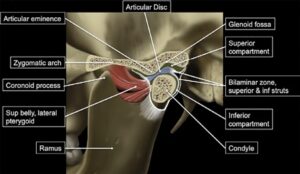(Swedish below)
Please see more new TMJ texts at https://www.boaim2.se/rd-foundation/tmj-as-a-multidisciplinary-hub/ and sub pages
TMJ picture below where the upper temporal part including the nose pars are left out
NB how close ear canal is where very smal Temporal bone is a wall to both, where in ear canal also exostoses (https://med.stanford.edu/ohns/OHNS-healthcare/earinstitute/conditions-and-services/conditions/exostoses.html#:~:text=How%20is%20it%20treated%3F,and%20reconstruct%20the%20ear%20canal.) + (Hereditary Multiple Exostoses: Current Insights https://www.ncbi.nlm.nih.gov/pmc/articles/PMC6916679/ can be bony overgrowths in the ear canal giving natural acoustic distortions.
TMJ Internal Derangements https://www.oralhealthgroup.com/features/tmj-internal-derangements/#:~:text=It%20is%20commonly%20accepted%20that,fossa%20up%20the%20articular%20eminence. “Normal TMJ Anatomy2
As indicated by its name, the temporomandibular joint is the articulation between the mandibular condyle and the temporal bone fossa. These bones are buffered by a biconcave disc of fibrocartilage that is best thought of by its boundary attachments:
The lateral disc is anchored to the mandibular condyle via collateral ligaments, but is also integrated into the joint capsule itself. These ligaments serve to stabilize the disc in the joint.
The posterior disc is connected to the highly vascularized and innervated retrodiscal tissues, which connect to both the condyle and the temporalis bone. The retrodiscal tissues are also connected to the discomalleolar ligament,3 which originates in the middle ear. The retrodiscal tissue is passive in the closed position, but will limit the motion of the disc during maximum opening.
The anterior disc has connection with the joint capsule and the superior head of the lateral pterygoid muscle. The superior portion of the lateral pterygoid appears to contract during closing, stabilizing the disc during chewing.
The joint is innervated by the auriculotemporal and masseteric nerves, which are branches of V3”
The figure illustrates the different components of the temporomandibular joint. Contributed by Bruno Bordoni, PhD5
Fig 1: “Normal TMJ Function
It is commonly accepted that the temporomandibular joint has both rotational movement and translational movement, making it a ginglymoarthroidial joint. The mandibular condyle will rotate on the inferior surface of the disc and the superior surface of the disc will slide from the fossa up the articular eminence. Right and left lateral movements primarily involve translational movements by the contralateral joint (e.g. a left lateral movement involves translation of the right condyle). The complex nature of all mandibular movements is beyond the scope of this paper, but these basic movements can be demonstrated in any clinical setting”
… Over time, the disc may become abraded by the condyle, especially if the condyle has a more flattened architecture. Ongoing abrasion of the disc may lead to its perforation, resulting in continued popping with a grinding sound or “crepitus”* and worsening of the condition.”
BvS> Suspected I myself had a fissure/crack/burst .. at the bridge of the nose left side of the Septum as an unsuspected consequence of head trauma accident (head, somewhat more to the left side, first into a concrete pillar in 2018) of several reasons, one of which was that when I started rinsing my nose with water (the principle of communicating vessels, e.g. as water towers apply) I got sharp pain on the left side in at the ”front”, just above, of the left ear a distinct point – very painful, that I never got. Could be due to the natural ”path” that lies between one and the other nostril inclination, which at least I don’t know about!
Svenska:
”Med tiden kan skivan bli slipad av kondylen, särskilt om kondylen har en mer tillplattad arkitektur. Pågående nötning av skivan kan leda till dess perforering, vilket resulterar i fortsatt poppning med ett slipande ljud eller ”crepitus”* och försämring av tillståndet.
* Crepitus är rasande, sprakande eller knäppande ljud och förnimmelser som upplevs under huden och lederna eller en sprakande känsla på grund av närvaron av luft i den subkutana vävnaden .
Ljudet kan skapas när två ojämna ytor i en organisms kropp kommer i kontakt – till exempel vid artros eller ledgångsreumatism när brosket runt leder eroderar och ytorna i leden maler mot varandra, eller när de två frakturerade ytorna på lederna brutna ben gnuggar ihop. Crepitus är ett vanligt tecken på benfraktur .
Crepitus kan lätt skapas och observeras genom att utöva en liten mängd kraft på en led och på så sätt ” spricka den ”. Detta orsakas av att det bildas bubblor av kväve i ledvätskan som spricker. Nästan varje led i kroppen kan ”sprickas” på detta sätt, men de leder som kräver minst ansträngning inkluderar hallux , knogar och nackleder.
I mjuka vävnader kan crepitus bildas när gas förs in i ett område där det normalt inte finns.
Termen kan också användas för att beskriva de ljud som produceras av lung tillstånd såsom interstitiell lungsjukdom -Dessa också kallas ” rassel ”. Crepitus är ofta tillräckligt hög för att höras av det mänskliga örat , även om ett stetoskop kan behövas för att upptäcka fall orsakade av luftvägssjukdomar .
I tider av undermålig kirurgisk praxis involverade postoperativa komplikationer anaerob infektion av Clostridium perfringens- stammar , vilket kan orsaka gasbrand i vävnader , vilket också ger upphov till crepitus. https://hmn.wiki/sv/Crepitus
BvS> Misstänkt jag själv hade sprickbildning vid näsroten vänster sida av Septum som en ej misstänkt konsekvens av huvudtrauma olycka (handlöst med huvudet före in i en betongpelare 2018) av flera skål varav ett var att när jag började skölja näsan med vatten (principen kommunicerande kärl, t.ex. som vattentorn tillämpar) så fick jag skarp smärta på vänster sida en en distinkt punkt – mycket smärtsam, som jag aldrig fått. Kan ju bero på naturlig ”väg” som åtminstone jag inte känner till!
More to work on:
TMJ crepitus – Google Search
https://www.google.com/search?q=TMJ+crepitus&client=ms-android-samsung-ss&sca_esv=593389473&biw=384&bih=721&sxsrf=AM9HkKnHmH0vR4Oq-0tg9Ogz1s5_5bHv3w%3A1703408610230&ei=4vOHZafUDbG6wPAPkrSYkA0&oq=TMJ+crepitus&gs_lp=EhNtb2JpbGUtZ3dzLXdpei1zZXJwIgxUTUogY3JlcGl0dXMyChAjGIAEGIoFGCcyBRAAGIAEMgUQABiABDIFEAAYgAQyBRAAGIAEMgUQABiABDIFEAAYgAQyBRAAGIAESNZZUPsLWK0ncAF4AZABAJgBkAGgAZgHqgEDMi42uAEDyAEA-AEBwgIKEAAYRxjWBBiwA8ICBhAAGBYYHsICCxAAGIAEGIoFGIYDwgIFECEYoAHiAwQYACBBiAYBkAYI&sclient=mobile-gws-wiz-serp
Temporomandibular Disorders (TMD or TMJ Problems) – Creptius
Understanding The Noises TMJ Makes | Marlen Elite Dental Wellness – Tinnitus
Temporomandibular Syndrome – StatPearls – NCBI Bookshelf (Creptius)
https://www.ncbi.nlm.nih.gov/books/NBK551612/#:~:text=The%20two%20common%20joint%20sounds,articular%20surfaces%20during%20mandibular%20movement.
TMJ Disorders Norwood MA, TMJ Mansfield MA Creptius
https://www.massoralsurgery.com/oral-surgery-procedures/tmj-disorder/#:~:text=Crepitus%20(grinding%20sound)%20is%20usually,the%20skull%20(glenoid%20fossa).
Why TMJ Noise Is Important | Cosmetic Dentistry | Dr. Henry – Creptius
https://www.drhenrysmiles.com/blog/why-tmj-noise-is-important#:~:text=Another%20sound%20that%20is%20not,the%20mouth%20opens%20and%20closes.
TMJ Disorders Norwood MA, TMJ Mansfield MA Creptius
https://www.massoralsurgery.com/oral-surgery-procedures/tmj-disorder/
More is to come …


